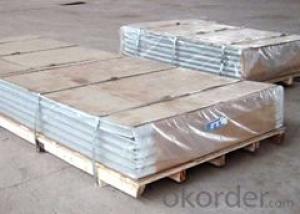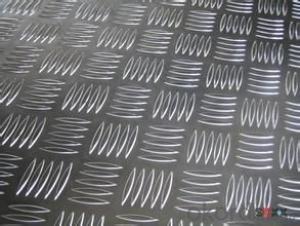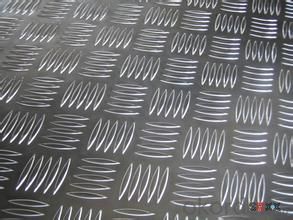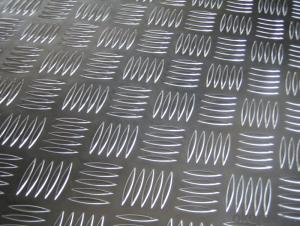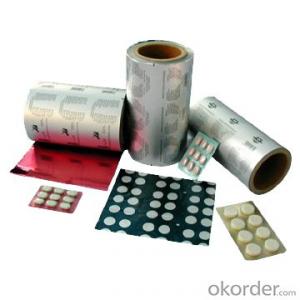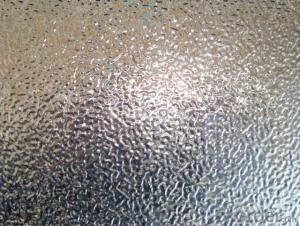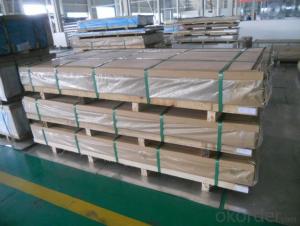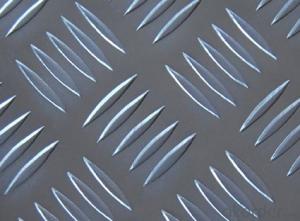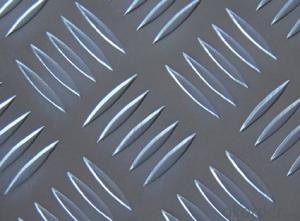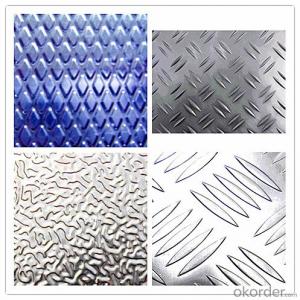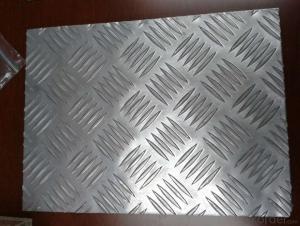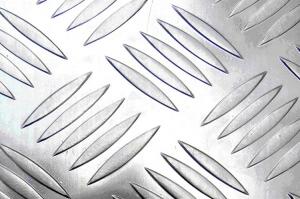Wholesale Aluminum Decorative Sheets - Alu Plate with Five Bars Pattern
- Loading Port:
- China Main Port
- Payment Terms:
- TT OR LC
- Min Order Qty:
- -
- Supply Capability:
- -
OKorder Service Pledge
OKorder Financial Service
You Might Also Like
Aluminium is a relatively soft,durable, lightweight, ductile and malleablemetal with appearance ranging from silvery to dull gray,depending on the surface roughness. It is nonmagnetic and does not easilyignite. A fresh film of aluminium serves as a good reflector (approximately92%) of visible light and an excellent reflector (as much as98%) of medium and far infrared radiation. The yield strength of pure aluminium is 7–11 MPa,while aluminium alloys have yield strengths ranging from200 MPa to 600 MPa. Aluminium has about one-third the density and stiffnessof steel. It iseasily machined,cast, drawn and extruded.
Alu Plate
Aluminum trade plate have great suctility,heat conductivity, anti-corrosion and moisture resistance properties.
Alloy: AA1050,1060, 1100, AA3003, 3005, 3015, 5052, 5754, 5083,8011, etc
Temper: H14/16/18/22/24/32,HO etc.
Thickness:0.2mm—100mm
Width:100mm—2300mm (Can be slitted)
Application:
Anti-sliperypurpose in vehicles, packing and appliance, decorative purpose
- Q: My frame snapped and I want to fix it by welding it back together. In order to do that, I need to know what all is in the aluminum.
- You can NOT weld back an aluminum frame unless you have the facilities to anneal and heat treat the frame again. Rewelding without the post treatments will result in a very soft area around the new weld causing sudden catastrophic failure... this means if you are riding it could fail at any time causing injury or death. EDIT: Wait just a durn minute. The 2100 and 2300 had carbon fiber tubes bonded to aluminum lugs and stays. If your bike failed then you ABSOLUTELY should not try to weld it. The heat from welding (even if you had post treatment facilities) would destroy the bond between the CF and aluminum. Fair warning- cut the frame apart and throw it away.
- Q: What are the common sizes of aluminum sheets?
- The industry and application determine the common sizes of aluminum sheets. However, there are several standard sizes that are readily available. For general fabrication and construction, aluminum sheets typically range in thickness from 0.020 inches to 0.125 inches. These sheets are commonly found in sizes such as 4 feet by 8 feet, 4 feet by 10 feet, and 5 feet by 10 feet. In the automotive industry, aluminum sheets are frequently used for body panels and structural components. The sizes used in this sector can vary from 0.040 inches to 0.125 inches in thickness, with dimensions depending on the specific application or vehicle model. When it comes to aerospace applications, aluminum sheets are usually thinner and smaller. These sheets can be anywhere from 0.010 inches to 0.080 inches in thickness, with dimensions generally being smaller compared to other industries. It's important to note that while these sizes are common, custom sizes can also be manufactured to meet specific project requirements. Furthermore, specialized industries may have unique size requirements that differ from the general standards. Therefore, it is always advisable to consult suppliers or manufacturers to determine the most suitable size for a particular application.
- Q: Does aluminum resist fire or is it not susceptible to catching fire?
- <p>Aluminum sheets are not fireproof but have a high resistance to fire. They do not burn or support combustion like wood or paper. Aluminum has a melting point of around 660掳C (1220掳F), and it forms a protective oxide layer when heated, which prevents further oxidation and slows down the heating process. While it can get hot and deform under extreme heat, it won't catch fire or contribute to a fire's spread. However, it's important to note that aluminum can still conduct heat, so it's not completely immune to the effects of fire.</p>
- Q: Aluminum plate 90 degree bending, why cracking?
- Cracking of 90 degree bending of aluminium plate:1 bend radius is too small2, more impurities aluminum plate
- Q: Can 101 aluminum sheets be recycled?
- Certainly, it is possible to recycle 101 aluminum sheets. Aluminum possesses a remarkable recyclability, boasting an impressively efficient recycling procedure. Through the act of recycling aluminum sheets, we not only preserve valuable resources but also conserve energy and diminish greenhouse gas emissions. Additionally, recycling aluminum aids in the reduction of landfill waste and curtails the necessity for fresh aluminum ore mining. Consequently, we highly recommend recycling 101 aluminum sheets to actively contribute towards a future that is more sustainable and environmentally conscious.
- Q: Can aluminum sheets be bent or formed into different shapes?
- Yes, aluminum sheets can be easily bent or formed into different shapes due to their malleability and ductility.
- Q: What are the methods to protect aluminum sheets from corrosion during their usage?
- <p>To prevent corrosion of aluminum sheets during use, several strategies can be employed. First, apply a protective coating such as paint, anodizing, or a conversion coating to create a barrier against corrosive elements. Second, ensure proper cleaning and drying to avoid the accumulation of moisture and contaminants. Third, use corrosion inhibitors in environments where aluminum is exposed to aggressive chemicals. Fourth, maintain good ventilation to reduce humidity levels. Finally, regularly inspect and maintain the aluminum sheets to address any signs of corrosion early. These measures can significantly extend the lifespan and performance of aluminum sheets.</p>
- Q: Does exposure to ultraviolet (UV) rays impact the properties or longevity of aluminum sheets?
- <p>Aluminum sheets are generally resistant to UV rays, which means they do not degrade or corrode due to exposure to sunlight or UV radiation. Aluminum has a high reflectivity and can reflect most of the UV rays, minimizing the impact on its surface. However, prolonged exposure can cause a slight change in color, known as patina, which is a natural oxidation process and does not compromise the integrity or strength of the material. Overall, aluminum maintains its properties well under UV exposure, making it a suitable material for outdoor applications.</p>
- Q: What are the different types of alloys used in aluminum sheet?
- There are several different types of alloys used in aluminum sheet, including 3003, 5052, and 6061. Each alloy has different properties and is used for specific applications based on factors such as strength, corrosion resistance, and formability.
- Q: What are the different types of coatings applied to aluminum sheet?
- There are several different types of coatings that can be applied to aluminum sheet, each with its own unique properties and benefits. Some of the most common types of coatings include: 1. Anodizing: This is an electrochemical process that forms a protective layer of aluminum oxide on the surface of the sheet. Anodizing provides excellent corrosion resistance and enhances the appearance of the aluminum by creating a durable, colorful finish. 2. Powder Coating: In this process, a dry powder is electrostatically applied to the aluminum sheet and then cured under heat to form a hard, protective coating. Powder coating offers excellent durability, resistance to chipping and scratching, and a wide range of colors and finishes. 3. Paint: Aluminum sheet can also be coated with paint, which provides both aesthetic and protective benefits. The paint can be applied in liquid form and then cured under heat to form a strong, durable coating. Paint coatings offer a wide range of colors and finishes, allowing for customization and design flexibility. 4. Laminating: Laminating involves applying a thin layer of protective film or laminate to the surface of the aluminum sheet. This coating provides additional protection against scratches, abrasion, and UV damage, while also enhancing the appearance of the sheet. 5. Conversion Coatings: Conversion coatings are chemical treatments that convert the surface of the aluminum sheet into a more corrosion-resistant compound. Common conversion coatings include chromate conversion coatings and phosphating, which provide a protective layer that improves adhesion of subsequent coatings. 6. Clear Coatings: Clear coatings, such as lacquer or clear powder coat, can be applied to aluminum sheet to provide protection against oxidation and corrosion while preserving the natural appearance of the metal. Clear coatings are often used when the goal is to maintain the metallic look of the aluminum. These are just a few examples of the different types of coatings that can be applied to aluminum sheet. The choice of coating will depend on factors such as the desired appearance, level of protection required, and the specific application of the aluminum sheet.
Send your message to us
Wholesale Aluminum Decorative Sheets - Alu Plate with Five Bars Pattern
- Loading Port:
- China Main Port
- Payment Terms:
- TT OR LC
- Min Order Qty:
- -
- Supply Capability:
- -
OKorder Service Pledge
OKorder Financial Service
Similar products
Hot products
Hot Searches
Related keywords
